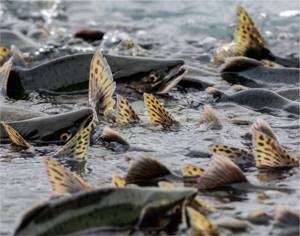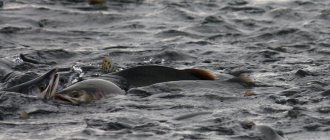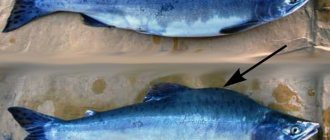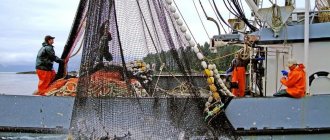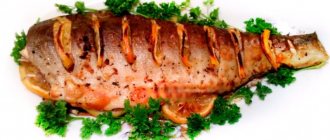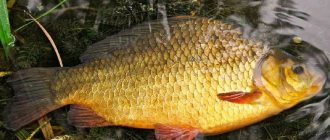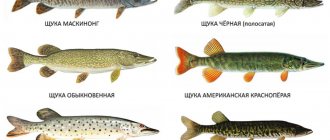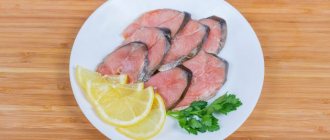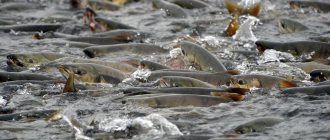Pink salmon is a fish that is ubiquitous in the cold waters of salt and fresh water bodies.
The predator has an attractive appearance, which changes during spawning. The meat of adult individuals is tasty and nutritious, but is much cheaper than other representatives of the salmon family. Let's look at where pink salmon are found, what they eat and what they look like. How do you cook pink salmon?
- Salting 46%, 991 votes
991 votes 46%991 votes - 46% of all votes
- Baking in the oven 40%, 855 votes
855 votes 40%
855 votes - 40% of all votes
- Other 8%, 164 votes
164 votes 8%
164 votes - 8% of all votes
- Varka 5%, 103 votes
103 votes 5%
103 votes - 5% of all votes
- In salads 2%, 50 votes
50 votes 2%
50 votes - 2% of all votes
Total votes: 2163
18.06.2020
×
You or from your IP have already voted.
Habitat
Pink salmon live in cold salty and fresh water bodies. In warm water at a temperature of 25°C, individuals die. The most optimal temperature conditions are from 5 to 14°C.
Fish can be found in large numbers on the American and Asian coasts of the Pacific and Arctic Oceans, from the Northern Californian Sacramento River to the Canadian Mackenzie, from the Siberian Lena to the shores of Korea.
Pink salmon can migrate thousands of kilometers from the freshwater body of water in which they were born. The life cycle is divided into two even periods - sea and river.
In some countries, the population of the species is so large that they are trying to destroy many individuals. It turned out that they do not belong to foods suitable for human consumption. In Norway, such fish really clog up water bodies, so they are fed to domestic animals or disposed of, but not caught for sale. Individuals came to this country in the 60s of the 20th century and occupied most of the rivers. Norwegians do not recognize pink salmon and consider it an alien species and do not eat it. Residents believe that the appearance of such fish has caused significant harm to the country's ecosystem. This is especially noticeable during spawning periods, when fish remains of individuals that spawned and died of natural causes are scattered everywhere. The corresponding photos can be found on the Internet.
Where is it found in Russia
In Russia, pink salmon can be found along the entire coast of Siberia from the Lena River to Peter the Great Bay. She lives and swims in the area of the Commander and Kuril Islands, on Sakhalin.
Around the middle of the 20th century, attempts were made to introduce pink salmon into the waters of the Murmansk region. For this reason, the fish spread throughout the Kola Peninsula. It is difficult to calculate how many salmon are present there at the moment.
Unlike Norway, Sweden and other Scandinavian countries, in Russia Far Eastern fish is highly valued for its pleasant taste, health benefits and low price compared to other representatives of salmon. Despite the relative toughness and dryness of meat, it has nutritional value and is rich in useful substances necessary to maintain the proper functioning of the human body.
Calorie content of pink salmon
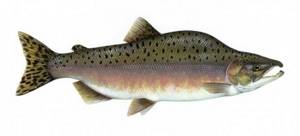
The calorie content of pink salmon in 100 grams is 130 kilocalories. The product belongs to the dietary group. Fish meat gives a quick feeling of fullness, which in turn prevents overeating. This makes the flesh of this fish a valuable product among people who watch their figure and lead a healthy lifestyle. Fish contains cholesterol in a form that is beneficial for humans. It synthesizes testosterone. Pink salmon is recommended for people involved in strength sports.
Pink salmon is an amazing and unique fish in its way of life and behavior. Its main purpose of existence is procreation. This fish is an incredibly interesting creature from the point of view of its life cycle. Fishermen value this fish for its temperament and fighting character, and gourmets for its tasty and healthy meat.
Family and squad
The species in question belongs to the genus of Pacific salmon and the salmon family. Order - salmonids, class - ray-finned fish, phylum - chordates, class - ray-finned fish. The international scientific name of the species, adopted in 1792: Oncorhynchus gorbuscha. Habitat: fresh rivers and salt water bodies.
Scientists note that pink salmon are not in danger of extinction. This has been proven by numerous studies and is due to the ability of adult sexually mature individuals to produce numerous offspring (up to several thousand eggs at a time). For this reason, even changes in climatic conditions, natural enemies, human fishing and other factors cannot significantly affect the number of pink salmon as a representative of the salmon family.
Man has created special incubators where the fry are raised and then released into the wild. There is no need for artificial breeding of pink salmon, because it is not economically feasible.
Features of character and lifestyle
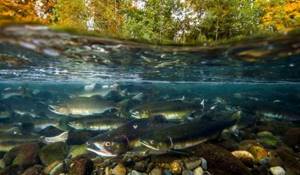
Photo: Pink salmon
Pink salmon are not tied to a specific habitat and can travel many hundreds of miles from their place of birth. Her whole life is strictly subordinated to the call of procreation. The fish age is short - no more than two years and it lasts from the birth of the fry to the first and last spawning in life. The banks of rivers where pink salmon come to spawn are literally littered with the carcasses of dead adults.
Being an anadrobic migratory fish, pink salmon feeds in the waters of the seas, oceans and enters rivers for spawning. For example, pink salmon begin to swim into the Amur immediately after the ice melts, and by mid-June the surface of the river is simply teeming with the number of individuals. The number of males in the incoming flock predominates over females.
The migrations of pink salmon are not as extensive and long-lasting as those of chum salmon. They occur in the period from June to August, while the fish do not rise high along the river, preferring to be located in the riverbed, in places with large pebbles and with the strongest water movement. After spawning completes, the spawners die.
All salmon, as a rule, have an excellent natural “navigator” and are able to return to their native waters with incredible accuracy. Pink salmon are unlucky in this regard - their natural radar is poorly developed and for this reason it is sometimes carried into places completely unsuitable for spawning or life. Sometimes the entire huge flock rushes into one river, literally filling it with their bodies, which naturally does not contribute to the normal spawning process.
Appearance
The name of this fish is directly related to how it looks. When males migrate to spawning grounds, a hump forms on their backs. For this reason, a representative of salmon is called pink salmon.
The weight of an adult can reach 2.2 kg. Body length is about 38 cm. This is one of the smallest representatives of the salmon family.
The entire body of the fish is covered with small bright silver scales. There are small dark spots on the back and in the area of the caudal fin. There is an accessory fin between the dorsal fin and the tail. This property is typical for most representatives of salmon fish.
A distinctive feature of the silverfish is its snow-white mouth. There are large dark spots above the head, on the sides and back. During the spawning period, the body turns light brown. Only the ventral part, which always remains white, as well as the fins and tail of dark tones do not change the shade.
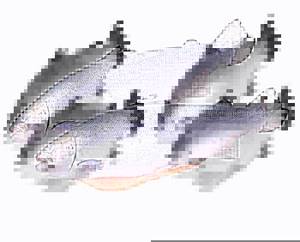
Pink salmon swimming in sea waters looks very beautiful. When entering fresh water bodies, the appearance of individuals, especially males, changes for the worse. During spawning, enormous changes occur in the appearance of the fish. Males not only acquire an unattractive hump on their back, but also large, sharp teeth. The jaws become longer and curved.
Pink salmon are often confused with chum salmon both in photos and in real life. Some characteristics are similar to other members of the salmon family. Characteristic signs by which pink salmon can be identified:
- color of the body, fins, abdomen, area above the head;
- size (chum salmon and other salmon fish are larger and weigh much more);
- external behavior of the offspring (pink salmon fry develop in fresh water for a certain time and only then head to the ocean);
- the size of the eggs (in pink salmon they are small);
- characteristics of the meat (in the species in question it is more red, while in chum salmon it is light pink);
- scales (pink salmon have smaller scales, there are dark spots on the back and tail);
- widespread (found everywhere, so it costs less than other salmon).
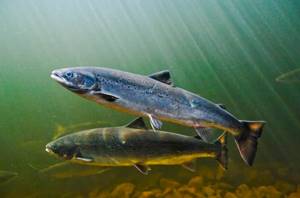
Pink salmon size
Pink salmon is the smallest representative of a large family. The size of pink salmon does not exceed 70 centimeters, and the weight is 2 kilograms. Males are much larger than females. There have been cases of catching fish weighing 5-6 kilograms, but this is rare.
The body of pink salmon is torpedo-shaped. The head is large, the mouth is large. The scales are small, and the color changes depending on the life stage. The lifespan of “pink salmon” is short compared to other fish. Pink salmon live 2-3 years. Due to such a short life, the fish grows quickly. The fish reaches its adult weight and length by one year, and at one and a half years it is ready to spawn. The fish fattens the bulk of its body weight while living in the sea.
White or red
The meat of young individuals that are “in the very juice” and have not yet laid eggs in freshwater bodies is described as having a red tint. However, in the store you can often find pink salmon products not only reddish in color, but also dirty gray and white. Both options are considered normal. In the first case we are talking about fish before spawning, in the second - about individuals that have completed their life cycle.
After spawning, pink salmon no longer accepts food, the functioning of its vital organs and systems is suspended, its reflexes are switched off, and it becomes hunchbacked. The meat loses its nutritional value and darkens. This product is considered feed and suitable for pet food. But a person can also eat such pink salmon if he is satisfied with the taste and appearance of the prepared fish dishes.
When choosing pink salmon products, you need to compare the contents of different packages if they are transparent. It often happens that goods from the same batch and in the same price category look and weigh differently. In this case, you need to give preference to fish that are reddish rather than white.
Rules for processing and storing pink salmon caviar
A distinctive property of salmon caviar is that it should never be stored at room temperature - only in the refrigerator. This product is perishable, so in retail outlets it is only found in display cases, inside of which there is slight frost (from -1°C).
The coldest sections of a household refrigerator are suitable for storing fish eggs. It can be placed close to the back walls, or placed on the top or bottom shelf adjacent to the freezer (depending on the model of the unit).
Important!
By setting the temperature for freezing salmon caviar too low, the housewife may end up with a shapeless porridge instead of a nutritious product. That is why you should stick to a temperature of –18°C (no more and no less), and defrost gradually in the refrigerator compartment. A very common way to store salmon caviar for a long time is to freeze it. This can be done in a regular freezer of a home refrigerator using the blast freezing method. In this case, fresh grains are moved from room temperature to frost not lower than –18°C. Under these conditions, the product will not lose its shelf life within a year, but the housewife should take into account that it will not be as tasty and nutritious as before cold treatment.
If you manage to buy a carcass that contains fresh caviar, the housewife can easily salt it herself, at home. To do this, you need to prepare a solution of salt and water - brine. Do not make the liquid too salty; the saturation should remain within 4%. For those who like salted salt, it is recommended to prepare a weaker brine with a strength of less than 3%.
Red caviar is much cheaper than black caviar, but this does not mean that it is inferior in taste. This product can be obtained in addition if you purchase a female pink salmon carcass in the store, caught before spawning. Skillful housewives will preserve the delicacy for a long time by salting it or placing it in the freezer.
Sea or river fish
Scientists and other specialists who study aquatic life and catch individual individuals have not come to a consensus whether pink salmon is a sea or river fish. It turned out that she constantly migrates, flocking into numerous flocks. The fish spends half its life in salty ocean waters, the other half prefers to be in freshwater rivers and lakes.

Fish move from the ocean to fresh water bodies, first singly and then in huge schools. Pink salmon set off at the moment when the ice cover begins to melt from the rivers.
For reproduction, this representative of salmon chooses clean streams with fast currents. Thus, spawning occurs in fresh waters. The fry that appear in non-salty water bodies develop there to certain parameters and then migrate to the ocean. Individuals under 2 months of age are extremely rare in the ocean.
Interesting! After spawning, the fish does not return to sea waters. Having laid eggs, it stops feeding and dies.
Ways to catch pink salmon

The most common methods of catching pink salmon are spinning and fly fishing.
Spinning is the main means of catching this amazing fish. Preferably, oscillating spoons with tees from 8.5 to 10. Lures should be chosen heavy, because fishing takes place in the fast flow of northern rivers. To successfully hunt for this bright representative of salmon, the fisherman must have certain knowledge and skills. It is necessary to “feel the river”, guess the deep places of the rifts, changes in depth, snags. It is in such places that the current is slow, which attracts predators. It is important to feel the bottom and keep the lure in close proximity. It is necessary to skillfully play the spoon at the bottom, and gradually reel in the reel. Pink salmon prefer baits that are orange, red and blue. Tees can be decorated with feathers and threads. All this attracts a predator.
The bite is felt slightly, with a double jerk or blow. The main thing is to quickly hook and hold the fish. She resists very actively. This is one of the strongest and fastest fish. Hooking a fish is one thing, but making sure it doesn't get off the hook requires a certain level of skill. The fish will rush from side to side, jump out of the water, shake off the hook. There are many more cases of unhooked fish.
In the Far East, fish are caught using the fly fishing method. They use fancy flies decorated with lurex. Sinking lines and heads are used. The flies should be played at a slow pace, with even jerks at the bottom.
If an angler approaches this type of fishing thoroughly, then positive emotions from the process are guaranteed. The fish is strong, graceful, and will fight to the end. This fishing can be called sport fishing.
Predator or not
Pink salmon is a predatory fish. She needs nutritious food of natural origin. The basis of its diet is small fish, as well as fry and numerous crustaceans. Individuals are very fond of eating midges, stonefly larvae, chironomids, and small copepods.
It happens that young fish feed on plankton and benthos. While in the shelf zone, pink salmon eat the larvae of bottom invertebrates. At great depths, the diet includes anchovies, squid, fry and other small water inhabitants.
Interesting! When the fish spawns, it stops feeding completely. This is due to the stoppage of the digestive system and inhibition of feeding reflexes.
Pink salmon itself can become food for other sea and river inhabitants or land animals. Caviar is eaten by many fish. Adults can become prey for toothed smelt and larger predator fish, seagulls, and ducks. While they are in salty waters, pink salmon are fed by seals, beluga whales, and sharks. During spawning, bears and otters, large birds of prey, will not refuse a fish treat.
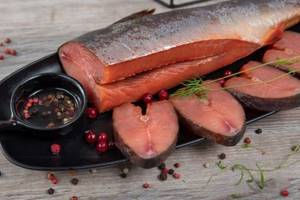
What do pink salmon eat?
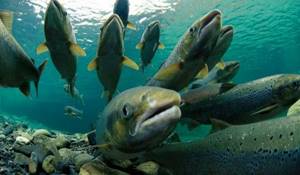
Photo: Pink salmon fish
Adults actively eat large groups of plankton and nekton. In deep-sea areas, the diet consists of juvenile fish, small fish, including anchovies and squid. Near the plume, pink salmon can completely switch to feeding on the larvae of benthic invertebrates and fish. Just before spawning, the fish’s feeding reflexes disappear, the digestive system completely atrophies, but despite this, the grasping reflex is still fully present, so during this period, fishing with a spinning rod can be quite successful.
Interesting fact: It has been noticed that in even years in Kamchatka and Amur pink salmon are smaller than in odd years. The smallest individuals weigh 1.4-2 kg and are about 40 cm long.
The young feed mainly on a variety of organisms that live in abundance at the bottom of reservoirs, as well as plankton. After leaving the river for the sea, small zooplankton becomes the basis of nutrition for young individuals. As the young grow, they switch to larger representatives of zooplankton and small fish. Despite their small size compared to their relatives, pink salmon have a faster growth rate. Already in the first summer season, the young individual reaches a size of 20-25 centimeters.
Interesting fact: Due to the great commercial value of pink salmon, in the mid-twentieth century several attempts were made to acclimatize this species of salmon in the rivers off the Murmansk coast, but they all ended unsuccessfully.
Varieties of pink salmon
This representative of the salmon family is an independent species and has no subspecies. This is explained by the ability of representatives of distant populations to interbreed with each other. In addition, most young healthy individuals most often remain in the same ocean conditions, migrating at a certain period of time to spawn. The lifespan of these aquatic inhabitants is very short, they are resistant to the effects of climate change during the spawning period.
However, scientists still note significant external differences between adult individuals living in salt and fresh water, which are periodically caught. There are also differences between the fish that come to brood in even and odd years. Unofficially, pink salmon is divided into 2 varieties: river and sea.
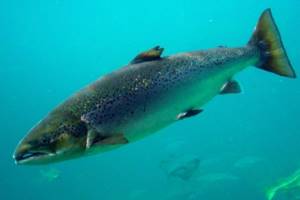
Natural enemies of pink salmon
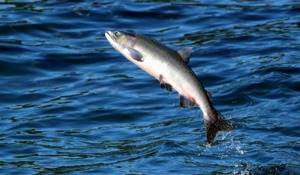
Photo: Female pink salmon
In their natural environment, pink salmon have more than enough enemies:
- caviar in huge quantities is destroyed by other fish, such as char, grayling;
- Seagulls, wild ducks, and predatory fish are not averse to feasting on the fry;
- adult individuals are included in the usual diet of beluga whales, seals, and herring sharks;
- at spawning grounds they are eaten by bears, otters, and birds of prey.
Fun fact: More than 37 percent of the world's Pacific salmon catches are pink salmon. The world catch of this type of fish in the eighties of the last century averaged 240 thousand tons per year. The share of pink salmon in the total salmon fishery in the USSR was about 80 percent.
In addition to enemies, pink salmon have natural competitors that can take over some of the food that salmon are accustomed to. Under some circumstances, pink salmon itself can cause a decline in the population of other fish species or even birds. Zoologists have noticed a connection between the increased population of pink salmon in the North Pacific Ocean and the decline in the number of slender-billed petrels in the southern part of the Ocean. These species compete with each other for food in the north, where petrels stop for the winter. Therefore, in the year when the pink salmon population grows, the birds do not receive the required amount of food, as a result of which they die during their return to the south.
Reproduction
At the age of about 2 years, adults leave salt waters and head to freshwater bodies to spawn. For spawning, pink salmon choose places with faster currents and a bottom that is covered with large pebbles. How does this salmon spawn:
- at the end of summer, females leave the sea and find themselves in fresh waters, and then dig small holes at the bottom of a river or lake using their tails (photos can be seen on the Internet);
- fish spawn (it also happens that the number reaches several thousand eggs);
- fertilization of germ cells by males occurs;
- the eggs are buried in sand and stones;
- adult individuals stop feeding and functioning normally, become unattractive and hunchbacked, and then die;
- in late autumn or early winter, fry emerge from the eggs;
- at the very beginning, the offspring of pink salmon eat the contents of the yolk sac in the eggs;
- the fry are actively growing and at the beginning of summer they set off for the ocean, feeding well along the way and developing normally;
- individuals live in salt water until the coming summer.
The diameter of the eggs is up to 8 mm. They are pale in color, but have a very durable shell.
Life cycle of pink salmon
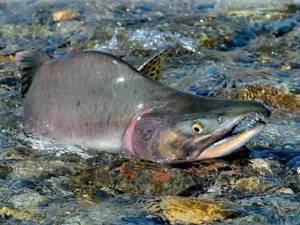
The life cycle of pink salmon passes only once and is divided into two stages: freshwater and sea. After spawning in August–October, the fish dies, and the larvae emerge from the eggs in December–January. Until spring, they will live in the spawning hole and feed on substances from the yolk sac. Once they reach a length of about 3 centimeters, they will head out to sea for the next few years of their lives. By the time they leave the river, many fish will change sex, and males and females will enter the sea. Many fry will not be able to grow up to be big fish, because there are so many people who want to eat small fish. The fish eat insects and crustaceans and grow quickly.
Sexual maturity in fish occurs at one and a half to two years. All this time, life at sea is considered feeding. The fish is actively feeding, growing, increasing in proportions and preparing for spawning. Upon reaching maturity, the fish will begin their first and only spawning journey. Moving up the rivers, they will stop feeding. During spawning in rivers, the number of males predominates. This is due to the fact that each new portion of eggs must be fertilized by a new male and pass on his gene code to it. After spawning, the adults will die and the eggs will be buried in the pebble bottom. After 1-2 months after spawning, the eggs will hatch into larvae that will remain in their nests until spring. In the spring, migration to the sea and a new cycle of life will begin. Due to this life cycle, these fish have a two-year periodicity in population changes.
Beneficial properties and harm of pink salmon meat
Such fish is a source of easily digestible protein, so the use of the product is recommended for weight loss and dietary nutrition due to health problems. Meat is healthy due to its content of polyunsaturated fatty acids and minerals.
What does regular consumption of this representative of the salmon family lead to:
- improvement of the condition of hair, nails, skin;
- strengthening bones and teeth;
- normalization of metabolism; slowing down the aging process of the body;
- improving performance and concentration, memory;
- increasing immunity;
- restoration of normal functioning of the nervous system;
- stimulation of the thyroid gland and the endocrine system as a whole;
- normalization of blood sugar levels;
- reducing the risk of developing malignant neoplasms;
- prevention of erosion processes in the gastrointestinal tract;
- prevention of heart and vascular diseases.
Pink salmon can be eaten by almost all adults and children. The exception is for persons with product intolerance and allergic reactions to seafood. Also, such fish should not be eaten by people with the following pathological processes:
- diseases of the stomach, intestines and other organs of the digestive system;
- diseases of the liver and urinary organs.
Serebryanka is contraindicated in case of intolerance to iodine and phosphorus. It is not recommended for small children under 3 years of age to eat it.
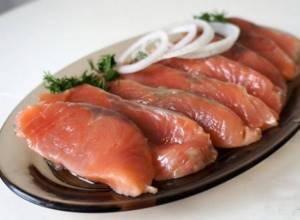
Gastronomic value of pink salmon
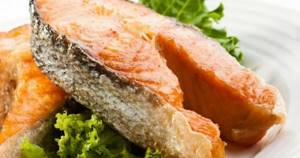
Pink salmon is a tasty and healthy fish. Its meat has a bright red-orange hue. It refers to red fish. Like any fish of the salmon family, pink salmon is of gastronomic value, because its meat is rich in vitamins, minerals and nutrients. The flesh is almost boneless.
This is a very tasty and healthy fish that can decorate any holiday table. Due to the fact that the color of its meat is bright orange, it is also called “red fish”. Meat contains up to 60 percent protein. In addition, fish is rich in retinol, B vitamins, and phylloquinone.
What does shabby mean?
There is a term called "hound" which is described as a fish that has undergone spawning changes before or after spawning. The meat becomes like a slippery mass of an unattractive brownish tint, and tastes worse than usual.
In stores you can find products made from pink salmon, the packaging of which is marked “fish with spawning changes.” This means that in an individual that has gained strength and weight on the way to the spawning site, after laying eggs, reverse processes are launched. She stops eating, her immune defense is completely switched off, her body does not receive proteins and other useful substances. The fish is still alive, but most vital processes are suspended, and life in nature enters its final stage. An individual that spawns only once acquires an unattractive appearance: the skeleton, jaws, and scales change, which can be seen in photographs on the Internet.
Enterprising fishermen easily catch barely fluttering bodies in large containers and transport the carcasses en masse for further cutting and packaging. If the packaging contains an insignia that it contains products with spawning changes, and the abbreviation “C20” is stamped on the tin can, then this is a thin fish that is better not to eat. The taste of dishes of this type leaves much to be desired. No matter how much this product is baked in various spices, it will not bring any benefit to the human body and will not bring much pleasure.
Pink salmon spawning - start and end times

Spawning of pink salmon begins in August and continues until mid-October. Pink salmon caviar are light orange balls about 5 mm in diameter. It has a slightly sweet taste, for which it is appreciated by most lovers of fish delicacies. Low-calorie pink salmon caviar is not only an indispensable attribute on the holiday table of gourmets, but is also recommended for consumption by those people who care about their health and adhere to a strict diet. Read also: Salting pink salmon caviar is tasty and simple
Where do pink salmon live?
Its habitat is the waters of the Pacific Ocean. It is found in the area of Sakhalin, the Kuril Islands, Kamchatka and off the coast of Japan. Sometimes it can be seen off the coast of the Arctic Ocean. Its main habitats are the American (up to Alaska) and Asian shores of the Pacific Ocean. The Sea of Okhotsk is distinguished by its rich catch.
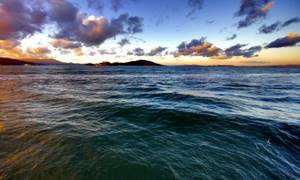
Fish rise to spawn in the following rivers: Kolyma, Lena, Sacramento, Indigirka, Colville and Mackenzie. Found on the Commander Islands, on the islands of Hokkaido and Honshu (northern part), etc.
Answering the question of where pink salmon is found - in the sea or in the river, we can say that in terms of habitat this fish is transitional, traveling from the sea to the river in connection with spawning. Moreover, while in the sea, the fine-scaled body of the fish has a beautiful silver color, and numerous small dark spots are scattered on the tail fin. When entering the river, the fish’s “outfit” changes: the previously dark spots only on the tail cover the head and entire body, merging into a single black spot by the time of spawning.
